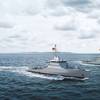Coast Guard Determines Cause of Collision
Polk was navigating through a fleet of small sailboats who were preparing for an upcoming race and several sailboats, including the one operated by Joel Lambinus, crossed safely in front of the tour boat without incident. The collision occurred when Lambinus altered course back into the tour boat's direct path only 50 to 75 yards ahead of the vessel. It was apparent that Lambinus was not aware of the vessel's location when he altered course back into its path. Polk did not sound any sound-signals prior to the collision but witnesses reported that the tour boat's engines were stopped seconds prior to the collision.
"The nautical rules of the road required all vessels to maintain a proper lookout, proceed at a safe speed consistent with traffic conditions and take necessary action to avoid collision", said Cmdr. John Mauger, chief of prevention at Coast Guard Sector Charleston. "This collision occurred due to failure to follow these important rules by both parties."
Per the nautical rules of the road, Polk was required to yield the right of way to the sailboats ahead of him. The rules further require that all operators take all possible actions to avoid imminent collisions.
Immediately after the casualty, the Spirit of Charleston made multiple radio calls on VHF Channel 16 (hailing and distress frequency) to race officials. The calls were answered by a race committee boat located near the commercial anchorage on the east side of the Middle Ground. During the subsequent conversation, the race official was apparently confused as to where the incident occurred and told the tour boat that no assistance was required and that the vessel need not remain in the area any longer. The Coast Guard was first notified about the collision an hour later by one of the race committee members who came to the sailor's rescue. Coast Guard investigators were dispatched to conduct interviews with the involved parties and witnesses. Polk completed post-casualty drug testing on the morning after the incident at his employer's direction. Alcohol testing was not conducted but there is no indication that drug or alcohol use contributed to the accident. The regatta, which consisted of two courses in the Middle Ground and one course on the Ashley River, was permitted by South Carolina Department of Natural Resources. The same permit application had been forwarded to the Coast Guard, but was received only days before the event, which didn't allow sufficient time for the Coast Guard to take action on the application.
Coast Guard investigators also identified a need for the race officials to establish and maintain better communications with commercial traffic during regattas. Only one of the race committee boats responded to the call on VHF Channel 16 at the time of the accident and neither the commercial vessel's captain nor the regatta officials communicated with one another on prior transits. As part of the event permitting process, the Coast Guard will require event safety officials to monitor both shipping and distress radio channels during future events in order to coordinate the safe passage of commercial vessels in the vicinity of events. Coast Guard investigators assembled electronic evidence and statements from multiple eye-witnesses to determine the facts involved in this casualty. The tour vessel owner, Fort Sumter Tours of Charleston, cooperated fully during the investigation. The Coast Guard casualty investigation report will be made available to the public after the completion of a routine internal administrative review.










